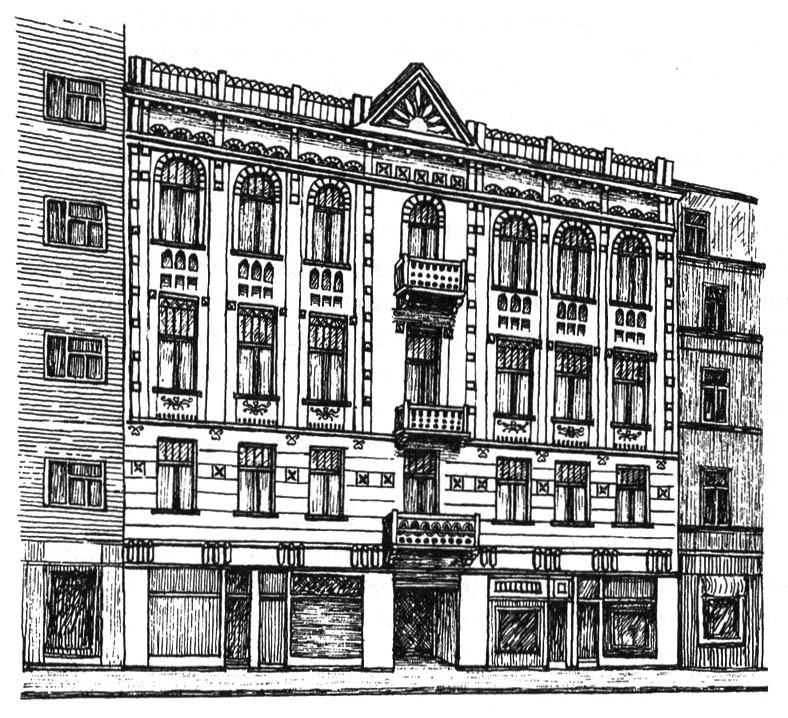Going further towards the end of Krakowskie Przedmieście on the left side, at the crossroads of several streets, we can see the statue of Nicolaus Copernicus, erected on the initiative of Stanisław Staszic, St. 1830 r. wg proj. Bertela Thorvaldsena. The plinth of the monument was designed by Adam Idźkowski and Antonio Corazzi. The monument was originally intended for Toruń, but when the city is in 1815 r. found itself outside the Kingdom of Poland, it was located in Warsaw. During the occupation, in 1944 r. the Nazis dismantled the monument and handed it over for scrap. In October 1944 r. The heavily damaged monument was found in Lower Silesia. Initially in 1945 r. fragments of it were placed on the pedestal, but after making additions, it returned to its place after four years.
Behind the monument, at the end of Krakowskie Przedmieście, there is the building of the Society of Friends of Sciences, called the Staszic Palace. Built in the years 1820-23 wg proj. Antonia Corazzie-go from the foundation of Stanisław Staszic. Society of the Friends of Sciences, for which it was built, was established in 1800 r. for the protection of cultural property, maintaining the national tradition and for the development of science, education and culture during the captivity period. Currently, it is the seat of the Polish Academy of Sciences.
The next section of the Royal Route is a bit narrower than Krakowskie Przedmieście, ul. New world. Its name appeared in the 17th century. and is associated with the then settlement along the road leading to Jazdów and Czersk. The buildings in Nowy Świat Street were mainly built in the 19th century. Tenement houses and palaces, usually two-story, predominate. Currently, there are shops and service points in the ground-floor part of the buildings.
 Tenement house at ul. Chmielna 30 in Warsaw
Tenement house at ul. Chmielna 30 in Warsaw
After the rest. on the street side at no. 67/69 there is a neo-renaissance palace of the Zamoyski family built in the 18th century. for the Branicki family, rebuilt at the end of the same century by jproj. Szymon Bogumił Zug, w XIX w. property of the Sapieha family, Świdziński, Zamoyski (then rebuilding under the direction of Henryk Marconi), ob. is a facility of the University of Warsaw. In the tympanum placed in the facade of the building – a group of Paweł Maliński's sculptures depicting mythological figures of Minerva, Cerera, Mercury and Jason as symbols of wisdom, agriculture, trade and wealth. In the palace lived and died in 1826 r. Stanislaw Staszic. Hence, in 1863 r. an unsuccessful attempt was made on the tsarist governor Theodore Berg. Here in September 1939 r. the Warsaw Defense Command was located.
Among the buildings of Nowy Świat, after crossing the intersection with ul. Świętokrzyska, the buildings at no. 64 (the tenement house of the Zrazowski family – classicist, with an elongated portico, built in the years 1820-30), no. 51 (Jabłonowski, rococo, built in the 18th century), no. 49 (classicist tenement house by Bentkowski – the work of Hilary Szpilowski from 1819-22), no. 35 (Burger tenement house decorated with a six-column Doric portico – the work of Frederic Albert Lessel z 1819 r.) and no. 19 (Kossakowski Palace, built in the 18th century, rebuilt in the 19th century. wg proj. Henryk Marconi), no. 18/20 (Baranicki's Palace – the only residence on this street with a courtyard, Classicist building was built in the middle of the. XIX w. wg proj. Henryk Marconi, in the interwar period it housed the British Embassy).
